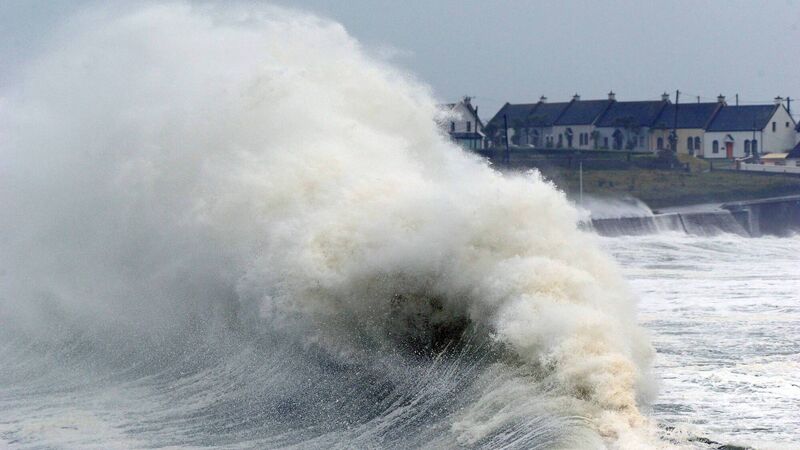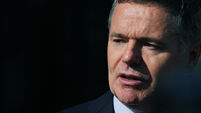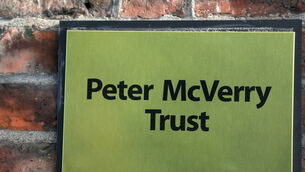Irish Examiner view: Our energy grid gamble on when the next big one arrives

Ireland looks set to be increasingly buffeted by more, and more powerful, storms which have the power to bring down significant portions of our electricity grid. File picture: Denis Minihane
When we consider Ireland’s energy needs — one of the topics of the week, as can be evidenced by discussions at the Oireachtas committee on housing and yesterday’s comprehensive supplement on renewables — it pays us to look at the wider context.
In other words, what is happening in the rest of the world?
We have a bulging book of evidence that what takes place elsewhere reaches our front door very quickly.
Global warming, and political attempts to ameliorate it, affect us all , and will radically impact on the choices available to future generations.
The wretched and damnable activities of Vladimir Putin kickstarted a crisis in power supply, whose financial consequences are tangible for practically every home in the land.
Demand is heading in one direction only, with projections that Ireland’s population will exceed 6.1m by 2040.
That’s nearly 1m extra people to keep warm in winter, and cool in summer, with many more apartments and homes to be serviced.
What is clear from the latest update to the International Energy Agency’s global outlook is that electricity is the star of the show with requirements projected to grow by 40% in the next 10 years.
China has accounted for the bulk of electricity growth in the past decade, and that is going to continue.
Emerging economies will require a much larger slice of the pie in the future while Europe and the US, where usage has been relatively flat in recent years, are also wanting more because of the rapid expansion of AI and the data centres.
The total metered electricity consumption of Irish data centres rose from 5% in 2015 to 22% last year, according to CSO figures.
Globally, other accelerated demand is driven by the expansion of air conditioning systems, ventilation, smart heating, and electric mobility.
Spending on electricity supply accounts for half of today’s global energy investment and prices have now become a key reference point for consumers and policymakers.
Electricity — now delivered for the first time ever more by solar and wind power than coal — accounts for only 21% of total final consumption, but is the key source for sectors which provide more than 40% of the global economy.
All of this underlines the importance of an electricity supply which is both secure and affordable.
As we observed yesterday morning, some 550,000 Irish households already fall within the official definition of energy poverty.
This might indicate that there is very little price elasticity in the system to fund major contributions to upgrading networks and grids.
We saw earlier this year some of the paralysing social and economic consequences of blackouts in Chile and on the Iberian Peninsula.
Trains ground to a halt, retailers were unable to handle card payments, and businesses closed en masse.
The power failure in Spain and Portugal lasted more than eight hours, trapping people in lifts and rail carriages with immoveable electric doors.
Ireland has roughly the same levels of renewables in its energy mix as Spain, 35%-40%, and that proportion is going to increase regularly.
The great challenge lies in providing the technology and storage to combat instability on the grid, along with coping with unforseen events.
In the October budget, the Government pledged to spend €3.5bn to “future-proof” our energy system. Building that resilience must be, as Cork Chamber CEO Conor Healy observed, “a national priority”.
Members of previous national administrations knew that this was so.
When Storm Éowyn hit Ireland in January, it caused widespread damage, outages, and at least one fatality.
Last month’s Storm Claudia also brought power lines down across Ireland.
Politicians of many hues will be keeping everything crossed that we can strengthen our networks before a big one arrives.
It’s a poignant thought in a week where there has been unbridled World Cup excitement that next Tuesday marks the 20th anniversary of the death of one of the finest players from these shores — or indeed anywhere — to never appear in that greatest of international tournaments.
Northern Ireland’s George Best, the ‘Belfast Boy’, died at Cromwell Hospital in London from multiple organ failure on November 25, 2005. He was aged 59 and had long struggled with alcoholism and a nomadic career following his golden days at Manchester United.
A liver transplant extended his life for three years, although he suffered complications from the immunosuppressive drugs he had to take.
Best, brought up in Cregagh in an Orange Order household, moved to Manchester aged 16, making his debut at 17. He left 11 years later with 179 goals, two league titles, and a European Cup.
For many, Best was the reason they fell in love with football. For others, he marked the moment when a player became a full-on commercial concern, a public property. You would need to be a certain age to remember his TV advertisement “E for B and Georgie Best” and recall what it meant: Eggs for breakfast.
Before he died, Best agreed to do an interview from his hospital bed with the News of the World. He was pictured with sunken eyes, and appearing jaundiced.
“Don’t die like me,” he urged other people struggling with alcohol problems. A selfless warning from someone still much missed.
The number of examples of Irish people dying in international conflicts in recent years has been mercifully small.
Some have lost their lives serving in Ukraine’s International Legion.
Simon Harris, speaking as foreign minister in September, confirmed that two Irish citizens died in Gaza while one was killed in Israel during the October 7, 2023, Hamas terrorist attacks.
And there was, of course, the sad case of Private Seán Rooney whose UN convoy was attacked in Lebanon at the end of 2022.
The commentary this week around the 50th anniversary of the death of the dictator Francisco Franco serves to remind us of an era when young men from this country were very prepared to take sides in arguments not of their making in much greater numbers.
Some lined up with the nationalists of the Spanish Civil War because of their support for the Catholic church, while the verdict of history tends to look more romantically on the communist and anarchist International Brigade.
Ireland had representatives in both camps. The historically problematic figure of Eoin O’Duffy took a 700-strong “Irish Brigade” overseas to purportedly defend Catholicism in 1936, but it was sent home by Franco the following summer and saw little action.
The Irish men in the International Brigades, more than 300 of them, took part in fighting before Madrid, and at the Battle of the Ebro, the largest and bloodiest confrontation of the war, in Catalonia. At least a quarter of the volunteers were killed before Franco’s final victory in the spring of 1939.
The last representatives of this blood sacrifice died in 2009 and 2011, and what they might have thought of this week’s valedictions to the former caudillo of Spain can only be imagined.
While there now exists a certain nostalgia from those who are susceptible to “strong leader syndrome”, it is easy to believe that the Internationalists would have nodded approval when the body of the “Generalissimo” was moved, on the instructions of the current prime minister, Pedro Sánchez, from the monumental Valley of the Fallen outside Madrid where it had lain from 1985 to 2019.
It was transferred to Mingorrubio-El Pardo municipal cemetery to be reburied alongside his wife. Mass was delivered by Ramón Tejero, an Andalucían parish priest and son of Guardia Civil lieutenant colonel Antonio Tejero, who stormed the Spanish Parliament in an unsuccessful military coup in 1981.
Franco now commands a certain cachet among those who are disillusioned with Europe’s political institutions and yearn for tradition and stability. Nearly 25% of Spaniards under the age of 25 said in a recent opinion poll that they admired him.
Those with longer memories will recall him as a repressive and authoritarian figure whose regime was unafraid to include prison and torture among its levers of power.
Leading the anti-Franco case is Mr Sánchez, Ireland’s closest ally in Europe, and a man struggling to hold together an unlikely coalition. Whether his country is best served by rekindling the embers of a divided past is doubtful. But it is a device which continues to serve politicians everywhere.












